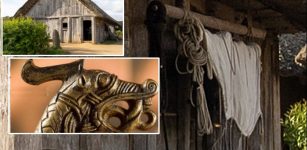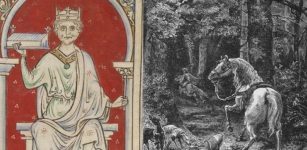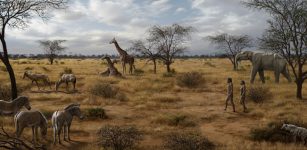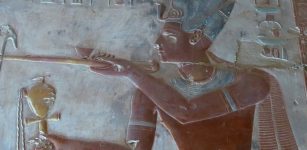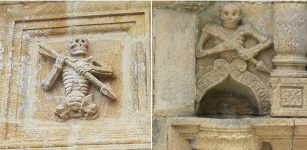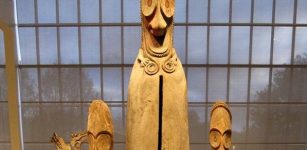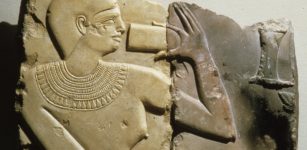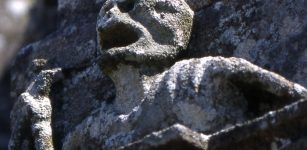‘Venus of Willendorf’: New Theory On ‘Venus’ Figurines – Proposed
Conny Waters – MessageToEagle.com – One of the world’s earliest examples of art, the enigmatic ‘Venus’ figurines carved some 30,000 years ago, has intrigued and puzzled scientists for nearly two centuries. The figurines dated to the Upper Paleolithic era represent the earliest examples of art that depicts humans and were created by nomadic hunter-gatherers.
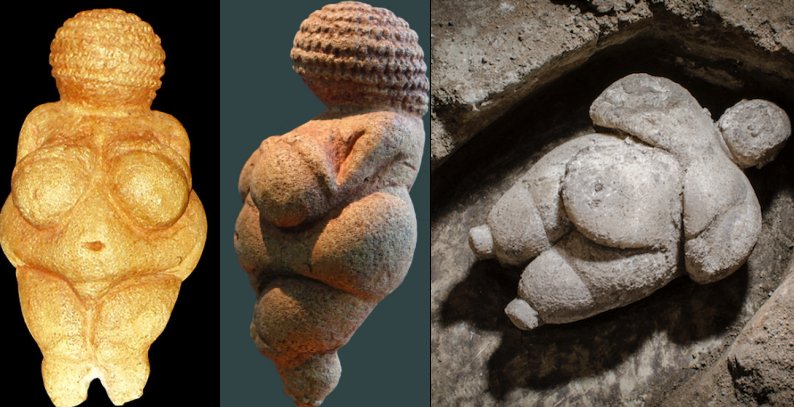 Left: Venus of Willendorf. Credit: Wikimedia/CC BY-SA 3.0; Middle: Venus of Willendorf, c. 24,000-22,000 BC, (Naturhistorisches Museum, Vienna), Right: Çatalhöyük, Research Project, source
Left: Venus of Willendorf. Credit: Wikimedia/CC BY-SA 3.0; Middle: Venus of Willendorf, c. 24,000-22,000 BC, (Naturhistorisches Museum, Vienna), Right: Çatalhöyük, Research Project, source
The so-called ‘Venus of Willendorf’, an 11.1-centimeter-tall (4.4 in) figurine was unearthed in excavations at a paleolithic site near Willendorf, a village in Lower Austria in 1908.
Now, a researcher and lead author of the paper Richard Johnson, MD from the University of Colorado School of Medicine believes he has enough evidence to solve the mystery behind these curious totems.
The depictions of obese or pregnant women, which appear in most art history books, were long seen as symbols of fertility or beauty.
However, according to Johnson, the key to understanding the statues lays in climate change and diet.
“Some of the earliest art in the world are these mysterious figurines of overweight women from the time of hunter-gatherers in Ice Age Europe where you would not expect to see obesity at all,” said Johnson.
“We show that these figurines correlate to times of extreme nutritional stress.”
Early modern humans entered Europe during a warming period about 48,000 years ago. They are known as an Aurignacian culture which first appeared in Europe some 43,000 years ago. They hunted reindeer, horses, and mammoths with bone-tipped spears. In summer they dined on berries, fish, nuts, and plants, and were busy producing bone tools, artifacts, cave paintings, jewelry, and musical instruments.
This culturally sophisticated and yet mysterious culture migrated from Europe to the Levant some 40,000 years ago.
As temperatures dropped, ice sheets advanced and disaster set in. During the coldest months, temperatures plunged to 10-15 degrees Celsius. Some bands of hunter-gatherers died out, others moved south, some sought refuge in forests.
It was during these desperate times that the obese figurines appeared. They ranged between 6 and 16 centimeters in length and were made of stone, ivory, horn, or occasionally clay. Some were threaded and worn as amulets.
The researchers measured the statues’ waist-to-hip and waist-to-shoulder ratios. They discovered that those found closest to the glaciers were the most obese compared to those located further away. They believe the figurines represented an idealized body type for these difficult living conditions.
“We propose they conveyed ideals of body size for young women, and especially those who lived in proximity to glaciers,” said Johnson, who in addition to being a physician has an undergraduate degree in anthropology. “We found that body size proportions were highest when the glaciers were advancing, whereas obesity decreased when the climate warmed and glaciers retreated.”
Obesity, according to the researchers, became the desired condition. An obese female in times of scarcity could carry a child through pregnancy better than one suffering malnutrition. So the figurines may have been imbued with a spiritual meaning—a fetish or magical charm of sorts that could protect a woman through pregnancy, birth, and nursing.
Many of the figurines are well-worn, indicating that they were heirlooms passed down from mother to daughter through generations. Women entering puberty or in the early stages of pregnancy may have been given them in the hopes of imparting the desired body mass to ensure a successful birth.
“Increased fat would provide a source of energy during gestation through the weaning of the baby and as well as much needed insulation,” the authors said.
Promoting obesity, said Johnson, ensured that the band would carry on for another generation in these most precarious of climatic conditions.
“The figurines emerged as an ideological tool to help improve fertility and survival of the mother and newborns,” Johnson said. “The aesthetics of art thus had a significant function in emphasizing health and survival to accommodate increasingly austere climatic conditions.”
Written by Conny Waters – MessageToEagle.com – AncientPages.com Staff Writer

